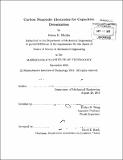| dc.contributor.advisor | Evelyn N. Wang. | en_US |
| dc.contributor.author | Mutha, Heena K | en_US |
| dc.contributor.other | Massachusetts Institute of Technology. Department of Mechanical Engineering. | en_US |
| dc.date.accessioned | 2014-03-06T15:44:55Z | |
| dc.date.available | 2014-03-06T15:44:55Z | |
| dc.date.copyright | 2013 | en_US |
| dc.date.issued | 2013 | en_US |
| dc.identifier.uri | http://hdl.handle.net/1721.1/85478 | |
| dc.description | Thesis: S.M., Massachusetts Institute of Technology, Department of Mechanical Engineering, 2013. | en_US |
| dc.description | Cataloged from PDF version of thesis. | en_US |
| dc.description | Includes bibliographical references (pages 80-85). | en_US |
| dc.description.abstract | Capacitive deionization (CDI) is a desalination method where voltage is applied across high surface area carbon, adsorbing salt ions and removing them from the water stream. CDI has the potential to be more efficient than existing desalination technologies for brackish water, and more portable due to its low power requirements. In order to optimize salt adsorption in CDI, we need a better understanding of salt adsorption and the electrode properties involved in ion removal. Current materials are highly porous, with tortuous geometeries, overlapping double layers, and subnanometer diameters. In this work, we design ordered-geometry, vertically-aligned carbon nanotube electrodes. The CNTs in this study have 2-3 walls, inner diameter of 5.6 nm and outer diameter of 7.7 nm. The capacitance and charging dynamics were investigated using three-electrode cell testing in sodium chloride solution. We found that the material capacitance was 20-40 F/g and the charging time varies linearly with CNT height. The data was matched with the Gouy-Chapman-Stern model indicating that porous effects were negligible. Charging rates of CNTs compared to microporous activated carbon fiber, show that CNTs are more efficient at charging by weight. However, densification and surface functionalization will be necessary to enhance CNT performance by planar area. Future work will involve investigating electrodes in a flow-through cell to use salt adsorption data to determine the influence on electrode thickness on salt adsorption in channel flow. | en_US |
| dc.description.statementofresponsibility | by Heena K. Mutha. | en_US |
| dc.format.extent | 90 pages | en_US |
| dc.language.iso | eng | en_US |
| dc.publisher | Massachusetts Institute of Technology | en_US |
| dc.rights | M.I.T. theses are protected by copyright. They may be viewed from this source for any purpose, but reproduction or distribution in any format is prohibited without written permission. See provided URL for inquiries about permission. | en_US |
| dc.rights.uri | http://dspace.mit.edu/handle/1721.1/7582 | en_US |
| dc.subject | Mechanical Engineering. | en_US |
| dc.title | Carbon nanotube electrodes for capacitive deionization | en_US |
| dc.title.alternative | CNT electrodes for capacitive deionization | en_US |
| dc.type | Thesis | en_US |
| dc.description.degree | S.M. | en_US |
| dc.contributor.department | Massachusetts Institute of Technology. Department of Mechanical Engineering | |
| dc.identifier.oclc | 870971328 | en_US |
